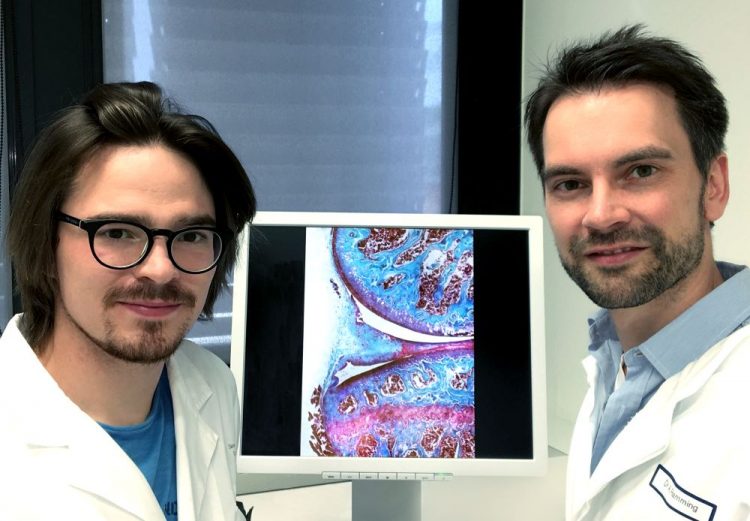Hibernating control cells or why inflammations become chronic

Simon Rauber (left) and Dr Andreas Ramming (Image: FAU/Andreas Ramming)
Rheumatoid arthritis is the most common autoimmune disease of the joints. It causes a chronic inflammatory response, with the body’s own immune cells attacking the joint, including the cartilage and bone. This process does not cease spontaneously.
An international research team headed by the rheumatologist Dr Andreas Ramming at Friedrich-Alexander-Universität Erlangen-Nürnberg (FAU) has now managed to identify an immune system cell type that can be used in a targeted attempt to control the inflammatory response in arthritis patients.
The results obtained by the research team at Department of Medicine 3 – Rheumatology and Immunology of Universitätsklinikum Erlangen – have been published in ‘Nature Medicine’.
In Germany some 800,000 people, preliminarily women, suffer from rheumatoid arthritis. This causes persistent inflammation that damages the joints and bones. Patients suffer pain and experience restrictions in terms of their mobility. “A particularly worrying aspect for those affected is the fact that the inflammatory response in joints is exceptionally chronic and thus usually requires lifelong treatment,” explains Prof. Georg Schett, director of the Department of Medicine 3.
Cells known as innate lymphoid cells usually manage the resolution of inflammations.
However, to date, little has been known about how inflammations clear up and why this process does not work in those suffering from rheumatism. Now a joint project involving researchers in London, Barcelona, Zurich, Indianapolis and Dublin has now enabled the researchers in Erlangen to solve this mystery. According to Simon Rauber, an immunologist in Erlangen and primary author of the study, a previously inadequately studied cell population of the immune system called innate lymphoid cells plays a major role in the resolution of inflammations.
It seems that innate lymphoid cells go into a kind of ‘hibernation’ in patients with rheumatism.
“In patients suffering from rheumatoid arthritis, these innate lymphoid cells are in a state of what can be described as hibernation and as a result the inflammation persists. When innate lymphoid cells are ‘woken up’, this puts a stop to the inflammation and to the damage to the joint,” adds principal investigator Dr Ramming. The discovery of this important mechanism could provide the opportunity to develop completely new options for treating chronic inflammatory diseases.
New forms of treatment monitoring
Even at this stage, measuring the number of innate lymphoid cells in the blood makes it possible to provide a prognosis of the effects of treatment. If there are few innate lymphoid cells in the blood, the disease will flare up and the joint will be further damaged. However, resolution of inflammation is associated with an elevation in the number of these cells. The measurement of blood levels makes it possible to initiate individual, more targeted treatment at an early stage, thus preventing another flare-up of the disease. “These findings will make it possible to significantly improve the quality of treatment of rheumatoid arthritis in future with the help of innate lymphoid cells,” says Dr Ramming.
Together against inflammation
“Collaborative Research Centre 1181 at Universitätsklinikum Erlangen and the priority programme ‘Innate Lymphoid Cells’ (SPP 1937) of the German Research Foundation (DFG) have made a decisive contribution to revealing this central immunological mechanism involved in the resolution of inflammations,” concludes Prof. Schett. The results of this study have been published in the journal Nature Medicine in an article entitled ‘Resolution of inflammation by interleukin-9-producing type 2 innate lymphoid cells’ (DOI: http://dx.doi.org/10.1038/nm.4373).
Further information:
Dr. Andreas Ramming
Phone: +49 9131 8539109
andreas.ramming@uk-erlangen.de
Media Contact
More Information:
http://www.fau.de/All latest news from the category: Life Sciences and Chemistry
Articles and reports from the Life Sciences and chemistry area deal with applied and basic research into modern biology, chemistry and human medicine.
Valuable information can be found on a range of life sciences fields including bacteriology, biochemistry, bionics, bioinformatics, biophysics, biotechnology, genetics, geobotany, human biology, marine biology, microbiology, molecular biology, cellular biology, zoology, bioinorganic chemistry, microchemistry and environmental chemistry.
Newest articles

Silicon Carbide Innovation Alliance to drive industrial-scale semiconductor work
Known for its ability to withstand extreme environments and high voltages, silicon carbide (SiC) is a semiconducting material made up of silicon and carbon atoms arranged into crystals that is…

New SPECT/CT technique shows impressive biomarker identification
…offers increased access for prostate cancer patients. A novel SPECT/CT acquisition method can accurately detect radiopharmaceutical biodistribution in a convenient manner for prostate cancer patients, opening the door for more…

How 3D printers can give robots a soft touch
Soft skin coverings and touch sensors have emerged as a promising feature for robots that are both safer and more intuitive for human interaction, but they are expensive and difficult…





















